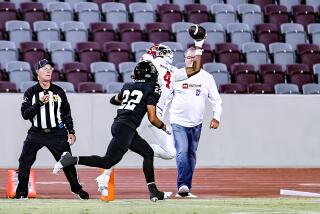A Heavy Issue
Bob Burt surveys the landscape of high school football and sees a growing trend, one that can be measured in pounds and inches.
Burt, the coach at Lake Elsinore Temescal Canyon, said the once-rare 300-pound lineman is no longer an aberration. Players in the 250 to 280-pound range are still big, but no longer a big deal.
“It seems like there’s a ton of them,” Burt said.
Long Beach Poly has nearly three tons. The combined weight of the 24 players listed as offensive or defensive linemen on the Jackrabbit roster tips the scales at 5,980 pounds.
Four Poly players--6-foot 7-inch Manuel Wright, 6-7 Winston Justice, 6-5 Maurice Murry and 6-1 Ernesto Villaseno--weigh 300 pounds or more. The nationally-ranked Jackrabbits, however, do not have a monopoly on monster-sized players.
Alta Loma, for example, boasts three 300-pounders on its offensive line. For better--and some say, potentially, for worse--diet, strength training and supplements all are contributing to the increase in massive linemen.
Who’s to credit? Or blame?
“It’s all dictated by what’s happening in the pros and the colleges,” Walnut Coach Jerry Person said. The New York Times reported last summer that a decade ago there were 38 players who weighed 300 pounds or more in the NFL. Last year, there were 280.
“It’s almost like if you’re not 300 pounds and not 6-foot whatever, you’re not going to make it,” Upland Coach Tim Salter said.
Gary Bernardi, UCLA’s recruiting coordinator, said that while 300 is regarded by some as a, “magic number,” it doesn’t necessarily translate into a college scholarship or pro football career.
“There’s a fine line between being a 300 pounder and being too big for who you are,” Bernardi said. “There’s a lot of 300 pounders that can’t bend their knees. Bigger is not always better.”
That line of thinking has not deterred high school players from beefing up.
Consider the case of Long Beach Poly’s Wright, a senior defensive lineman who is considered among the nation’s best at his position. Wright attributes his physique, in part, to summers spent visiting his grandmother in South Carolina.
“Every time I go down there, I grow wider or taller--sometimes it’s both,” Wright said. Wright said he was 6-4, 225 pounds after his freshman year, but returned from summer vacation 6-5, 280. He came back from South Carolina this summer weighing 310.
“We eat breakfast, lunch, dinner, supper, and if you’re hungry again they say, ‘Do you want more?”’ Wright said. “Down there, eating is no problem.”
During the school year, Wright said he does not eat as often.
“But when I get home,” he said, “I can grub.”
That is the same philosophy Los Angeles Fremont’s Marco Guerra subscribes to.
“My mom is a really good cook,” said Guerra, who is 6-51/2 and 322 pounds. “When I come home after practicing hard, I stack up.”
Like Wright and Guerra, Chino lineman Ryan Parks also goes all out on the field and at the dining room table. Parks, 6-5 and 295 pounds, downs nearly a half-gallon of milk a day. A typical lunch for him is three giant quesadillas; a typical dinner is several chicken breasts with rice or mashed potatoes.
“I go and I eat three big meals a day and go back for seconds and thirds. It seems like I’m always hungry,” he said.
High school football players also have developed an appetite for weight training unmatched by previous generations. Coaches universally cite improved strength development for gains in size.
“When I started coaching 30 years ago, the weight room wasn’t a big thing,” Westchester Coach Larry Wein said. “You did a little here and a little there. Now, it’s a regular thing.”
In some cases, it’s much more. Santa Ana Mater Dei Coach Bruce Rollinson, for example, said the Monarchs’ winning tradition was built upon a foundation achieved in the weight room.
“We spend as much time on strength and development as we do on offensive and defensive schemes,” Rollinson said.
Many schools have spent tens of thousands of dollars to build or upgrade their weight rooms and hire training personnel. Alta Loma’s weight room is a showpiece, with Olympic-caliber equipment rivaling that of some college facilities.
“We were lucky enough to get it and that has paid huge dividends,” Alta Loma Coach Tom Mitchell said. “When I first got here in 1995, to have a kid bench [press] 300 pounds was a rarity. Today, we have four or five who are pressing 400.”
Supplements such as creatine, ephedrine and androstenedione also have played a huge role in producing humongous players.
According to Robert Malina, a kinesiology professor at Michigan State and the director at the Institute for the Study of Youth Sports, a recent study cited 44% of senior athletes in U.S. high schools had taken creatine, a natural substance produced by the liver, kidneys and pancreas in minute levels.
The body requires around two grams of creatine a day, but athletes have seen enough of the benefits of over-the-counter creatine to make it a $260-million industry in 2000, according to the Nutritional Business Journal.
Wary of liability issues, not to mention uncertainty as to the long-term effects of supplements, many coaches frown on them. Few schools, if any, have a set policy against their use. Most coaches, however, know some of their players are taking them.
The recent deaths of Minnesota Viking offensive lineman Korey Stringer, Northwestern defensive back Rashidi Wheeler and others have focused attention on the use of supplements and possible dangers. Many coaches said the deaths have caused players to pause.
“Before the incidents of this year, I think kids were taking them without the thought of any consequences,” Los Angeles Dorsey Coach Paul Knox said. “I think they have backed up a little. Now coaches are making a conscious effort to tell their kids to leave that stuff alone.”
Still, with thousands of dollars in college scholarships to be earned and possibly millions more to be made as a pro, no one expects that prep athletes will stop their quest to become bigger. Malina, for one, is concerned about their future.
“Nobody’s addressed the issue if all these youngsters are too big for their size,” he said. “Will they lose that weight when they stop competing? By any criteria, all these kids would be considered obese. They’re muscular, but what’s going to happen 10 years from now when they’re not working out? What are the long-term effects of that size?”
More to Read
Get our high school sports newsletter
Prep Rally is devoted to the SoCal high school sports experience, bringing you scores, stories and a behind-the-scenes look at what makes prep sports so popular.
You may occasionally receive promotional content from the Los Angeles Times.







